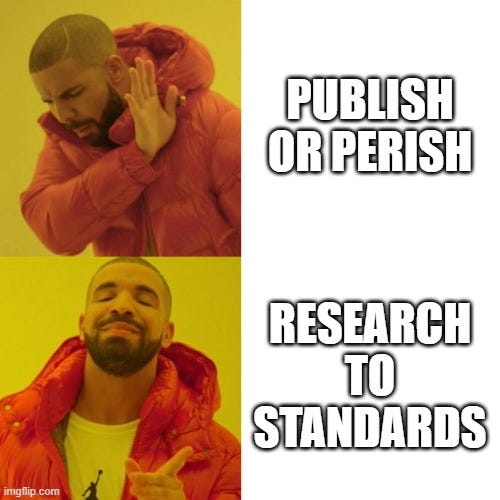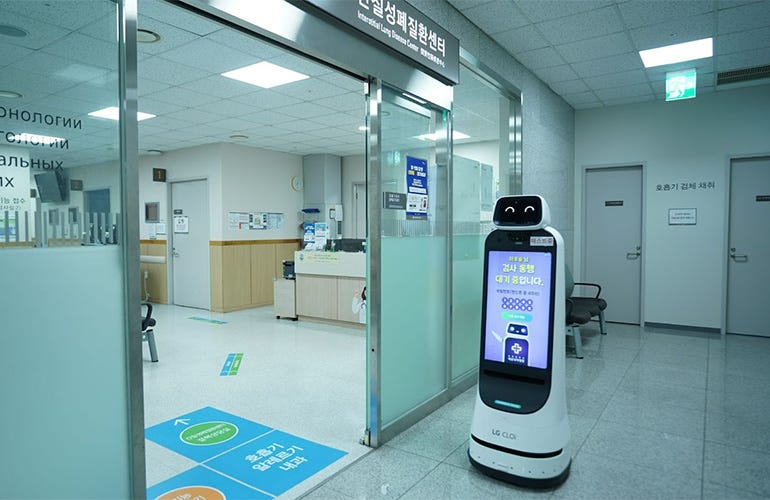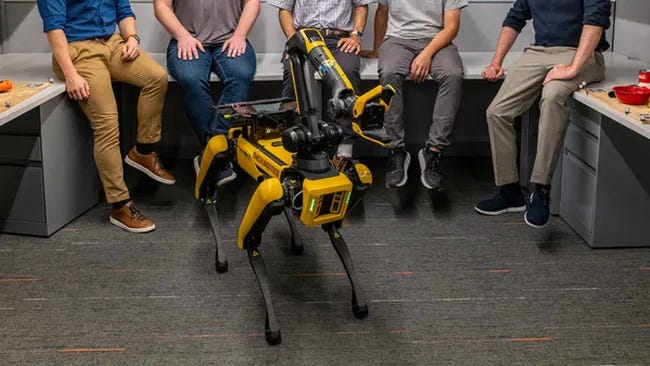We Need More Research That Creates Standards
Let's Get Rid Of "Publish or Perish" And Replace It With "R2S"
Aaron’s Thoughts On The Week
"Research is creating new knowledge." — Neil Armstrong
Research-to-Standards (R2S) initiatives play a crucial role in developing industry standards and advancing research across various fields, including fields as diverse as robotics, manufacturing, healthcare, environmental science, and even cannabis. The core of R2S efforts is to utilize rigorous research to create benchmarks that are essential for establishing new standards. These benchmarks serve as the foundation for standardization and encourage continuous innovation by providing measurable criteria that can guide future research.
Following A Proven Process
Transforming research into standards is a systematic, collaborative effort aimed at addressing specific, recurring challenges within industries—be it safety, quality, or interoperability. Researchers begin by identifying industry pain points, such as improving safety protocols, ensuring consistent product quality, or facilitating interoperability between systems. This phase often requires extensive data collection, hypothesis testing, and the development of prototypes or models to assess solutions’ efficacy. Through these steps, researchers gather insights that are essential for creating practical, enforceable guidelines.
The transition from research to standards is achieved through collaboration with industry stakeholders, including standards organizations like ASTM International and the International Organization for Standardization (ISO). These organizations provide a framework for establishing benchmarks that can be universally applied and recognized. By engaging with industry professionals, regulatory bodies, and technical experts, researchers ensure that proposed standards address real-world needs and integrate seamlessly into industry practices.
For instance, in the robotics industry, safety standards are crucial due to the close interactions between robots and human workers. Research into the mechanics of safe robot-human collaboration—such as acceptable distances, speed limits, and sensor accuracy—provides the basis for standardized safety protocols. These guidelines, developed with input from researchers, engineers, and industry leaders, not only protect workers but also create a clear foundation for future technological advancements, reducing workplace injuries and increasing productivity.
Standards in robotics, like the ISO 10218 for industrial robot safety or ASTM’s guidelines on autonomous systems, illustrate how collaborative efforts translate complex research into actionable, reliable standards. These standards do more than mitigate risk; they enable industries to innovate responsibly, fostering a safer, more connected future for all sectors.
One significant benefit of R2S initiatives is the establishment of benchmarks. These benchmarks serve as measurable criteria that industries and researchers can rely on to assess progress and performance. Depending on the field, benchmarks may include acceptable levels of emissions, load capacities, safety thresholds, or data security metrics. By setting these benchmarks through comprehensive research, standards organizations create a baseline that new technologies, products, or processes must meet to be considered safe, efficient, or reliable. This, in turn, stimulates further research and innovation, as companies and researchers strive to exceed these benchmarks, driving continuous improvement across industries.
Additionally, R2S initiatives create a feedback loop between research and industry standards. As new technologies emerge and industries evolve, research can expose gaps or new challenges that existing standards may not adequately address. This feedback loop allows standards to remain dynamic and adaptable. For example, as new automation technologies develop, R2S efforts might uncover insights about worker health and safety, leading to updates in standards related to ergonomics and human-robot interaction. This cycle ensures that standards are both scientifically grounded and responsive to real-world needs.
Getting Products To Market Faster
Research-to-Standards (R2S) initiatives are critical in accelerating the journey from groundbreaking research to practical, industry-wide applications. This approach shortens the often lengthy time it takes for research findings to become implemented as widely accepted best practices. By working closely with standards organizations, researchers can ensure that their discoveries are not only validated but also rapidly adopted across industries, creating immediate and actionable impact. This is something that “Publish or Perish” pressures discourage due to the push for quantity over quality work that be put to use.
R2S efforts are particularly impactful in industries experiencing fast technological advancements, such as robotics, biotechnology, and information technology. Here, translating research insights into standards quickly is essential to keeping pace with innovation. For example, in additive manufacturing (3D printing), where new materials and printing methods are frequently introduced, close collaboration with standards bodies has enabled researchers to rapidly create and update guidelines on material properties, safety protocols, and quality assurance. This partnership significantly reduces the lag between innovation and standardization, allowing businesses to adopt new methods and technologies without risking quality or safety.
Additionally, the R2S model can streamline regulatory compliance. When new research-based standards are accepted quickly, they become embedded into regulatory frameworks more efficiently, helping businesses remain compliant as technologies evolve. This proactive approach mitigates risks, reducing costly compliance delays or retrofitting issues later. In healthcare and pharmaceuticals, for instance, timely standards updates based on recent research help manufacturers meet stringent safety and efficacy requirements more efficiently.
These efforts also foster trust among consumers and industry professionals by establishing consistent, reliable practices that can be verified and reproduced. Industries are better positioned to implement cutting-edge innovations, knowing that these advancements are supported by a solid framework of research-backed standards, enabling safe and efficient technology adoption across the board.
Researchers Should Be Incentivized To Do More R2S Work
University Presidents looking to encourage Research-to-Standards (R2S) work can implement several initiatives to shift focus from the traditional "Publish or Perish" model toward impactful, standards-focused research. Here are three incentives that could help:
Establish Recognition and Funding for Standards-Focused Research
Create dedicated awards, grants, and funding streams for faculty and research groups involved in R2S projects. Recognizing standards-driven research achievements on par with high-impact publications can encourage researchers to prioritize work that leads to standards, especially when tied to incentives like promotion considerations, additional funding, or research support.
Integrate R2S Outcomes into Tenure and Promotion Criteria
Revise tenure and promotion criteria to formally include R2S contributions, such as the creation of industry standards, collaboration with standards bodies, or participation in the development of industry guidelines. This change encourages researchers to pursue standards-related work by rewarding it with career advancement, rather than only valuing traditional publications.
Build Partnerships and Dedicated R2S Programs with Standards Organizations
Develop partnerships with standards organizations (like ASTM International or ISO) and offer faculty fellowships, internships, or research opportunities that directly connect academic research with standards development. Creating R2S-focused research programs and workshops will provide researchers with the training, resources, and networks needed to engage effectively in the standards ecosystem.
By implementing these incentives, universities can help align academic research with industry needs and promote long-term impacts on technological and societal advancements through standards.
Example: The CHIPS ACT and Semiconductor Standards
The CHIPS and Science Act of 2022 mandates the National Institute of Standards and Technology (NIST) to enhance its role in developing technical standards, particularly within the semiconductor industry. This directive aims to bolster U.S. leadership in semiconductor research, development, and manufacturing.
Under the CHIPS Act, NIST is tasked with establishing the CHIPS Research and Development Office, which oversees several key initiatives:
National Semiconductor Technology Center (NSTC): A collaborative hub for semiconductor research and engineering, focusing on advancing U.S. competitiveness in this sector.
National Advanced Packaging Manufacturing Program: An initiative to develop cutting-edge packaging technologies essential for next-generation semiconductors.
CHIPS Metrology Program: A program dedicated to advancing measurement science, standards, and technology to support semiconductor innovation.
These programs underscore NIST's commitment to leading in standards development, ensuring that the U.S. remains at the forefront of semiconductor technology research. By actively engaging in standards creation, NIST facilitates the rapid translation of research into practical applications, fostering innovation and maintaining national competitiveness.
Let’s Start
R2S initiatives bridge the gap between groundbreaking research and practical industry standards, creating a pathway where innovations can be quickly and safely integrated into everyday applications. This approach ensures that scientific discoveries do not remain isolated in academic publications but actively contribute to enhancing industry practices and setting new benchmarks for quality, efficiency, and safety. By fostering partnerships between researchers, industry stakeholders, and standards organizations, R2S initiatives drive a cycle of continuous improvement, where the latest insights are readily translated into impactful guidelines.
This collaborative ecosystem benefits a broad spectrum of society. For industries, it offers a streamlined route to adopting the latest technologies with confidence, knowing that they are backed by well-researched, dependable standards. For workers, R2S efforts promote safer workplaces by reducing injury risks and enhancing safety protocols. Consumers, too, benefit from these standards as they reinforce product reliability, safety, and quality across sectors, from healthcare to technology. In this way, R2S programs don’t just support immediate needs; they create a forward-looking infrastructure that allows for adaptable, resilient progress, ensuring that new innovations are effectively harnessed to improve daily life and advance societal goals.
Robot News Of The Week
Robotics trials enhance Australia’s defense capabilities under AUKUS partnership
The Australian Defence Force (ADF) is advancing autonomous technology with the deployment of GUS, a surveillance robot supporting border security. Used by the Pilbara Regiment, GUS aligns with AUKUS goals and is designed for remote, long-term monitoring with an onboard generator for extended endurance. Developed with Outlook Industries, GUS boosts Australia’s industrial base and has been successfully tested in exercises like Talisman Sabre.
Australia’s 2024 defense budget includes $130 million to further develop robotic and autonomous systems, including the Ghost Shark, an autonomous underwater surveillance platform, and the Ghost Bat combat aircraft. These innovations highlight Australia’s commitment to integrating autonomous technologies across land, sea, and air for Indo-Pacific defense.
This Is a Glimpse of the Future of AI Robots
San Francisco-based startup Physical Intelligence is bringing the dream of a multi-tasking household robot closer to reality. The company has developed an advanced AI model capable of handling a variety of home chores, such as unloading dryers, folding laundry, and cleaning tables. This breakthrough was achieved by training the model on an extensive dataset, making the once sci-fi concept of a household robot, like Rosey from The Jetsons, seem within reach.
Bigwave Robotics offers robotics as a service for hospitals
Bigwave Robotics Inc., based in Seoul, South Korea, has introduced a Robot-as-a-Service (RaaS) model tailored for hospitals to support digital transformation in healthcare. This service enables hospitals to assign non-medical tasks like delivery, guidance, and cleaning to service robots, all managed through a central system. Bigwave, also known as My Robot Solution, offers robots that are customized for each hospital’s needs, with deployment and task scenario planning included.
The RaaS model has already been implemented at facilities like Hallym University Sacred Heart Hospital and Gyeonggi Provincial Medical Center Suwon Hospital. This approach addresses staffing shortages and rising patient demand, exacerbated by aging populations and the COVID-19 pandemic. Bigwave’s robots can perform tasks more consistently and efficiently, such as maintaining cleanliness, transporting medications, and guiding patients, freeing healthcare workers to focus more on patient care. Bigwave Robotics also provides RaaS solutions for other industries, including logistics and manufacturing, with robots ranging from cleaning and delivery robots to collaborative robots and autonomous mobile robots (AMRs).
Robot Research In The News
Boston Dynamics' robot dog Spot can now 'play fetch' — thanks to MIT breakthrough
In a recent study, researchers developed "Clio," an AI system enabling dog-like robots to quickly identify and focus on specific objects using on-body cameras and voice instructions. By applying the "information bottleneck" theory, Clio filters out irrelevant details, allowing the robot to zero in on only what’s necessary for a task, like retrieving a specified item.
Demonstrated on a Boston Dynamics Spot robot, Clio helped the robot navigate an office and complete tasks by creating a virtual map with only relevant objects. Combining large language models and computer vision, Clio enhances robots’ ability to understand and interact with their surroundings effectively.
How virtual cows could help improve human-robot interactions
A study using a video game to herd virtual cattle has revealed insights into human decision-making in movement and navigation, which could improve interactions with robots and AI. Researchers from Australia, Italy, and the UK used a model called dynamical perceptual-motor primitives (DPMPs) to simulate these decisions. DPMPs reflect how we coordinate movements in complex environments, focusing on immediate goals rather than detailed planning.
Participants herded cows into pens, and their choices were analyzed, allowing the DPMP model to predict about 80% of decisions accurately. This suggests that DPMPs could effectively model human movement in real-life scenarios like crowd management and search and rescue operations.
By adopting a first-person perspective in the game, the study captured more realistic decision-making. Professor Michael Richardson noted that this approach shows DPMPs can predict how humans direct virtual characters or robots, potentially leading to more intuitive AI and robotic systems. The findings highlight the promise of DPMPs in designing responsive systems and improving training for emergency responders.ic systems. The study underscores the potential of DPMPs to inform the design of responsive, intelligent systems and to enhance training simulations for emergency responders.
Meta is making a robot hand that can ‘feel’ touch
Meta has partnered with sensor company GelSight and South Korean robotics firm Wonik Robotics to commercialize tactile sensors for AI, aimed at scientific research rather than consumer use. These sensors are designed to enhance AI's understanding of the physical world. GelSight and Meta will bring to market the Digit 360, an advanced version of Meta's original Digit sensor. Digit 360 functions as a tactile fingertip, using an AI chip and approximately 18 sensing features to digitize touch signals, allowing AI to detect and respond to physical changes with human-level precision
.
Robot Workforce Story Of The Week
How These Companies Built Thriving Professional Development Programs for the Automation Industry
Professional development programs are vital in the automation industry, providing employees with the skills needed to drive innovation and address the skills gap and labor shortages. Studies indicate that finding qualified talent for technical roles will become increasingly difficult as many workers retire by 2030.
Companies like Omron and Festo have developed initiatives to upskill employees and prepare new talent. Omron's Sakura Program combines classroom training with hands-on experience, emphasizing mentorship and diversity. Festo Didactic focuses on practical training and Industry 4.0 solutions, allowing employees to earn degree credits while gaining relevant experience.
Companies stress the importance of collaborating with educational institutions and industry experts to keep programs engaging and relevant. Omron raises awareness about automation careers among students, while Festo continually adapts its training to rapidly changing technologies.
Overall, these professional development programs are essential for addressing talent shortages, retaining employees, and fostering innovation, making them crucial for industry growth.
Robot Video Of The Week
Atlas autonomously transports engine covers between supplier containers and a mobile sequencing dolly, using a list of bin locations for reference.
It employs a machine learning vision model to detect environmental fixtures and bins, along with a specialized grasping policy. All movements are generated in real-time without predefined actions.
Atlas can detect and respond to changes in its environment, such as moving fixtures or action failures like tripping and collisions, using a mix of vision, force, and proprioceptive sensors.
Upcoming Robot Events
Nov. 12-14 Intl. Symposium on Safety, Security, & Rescue Robotics (New York City)
Nov. 22-24 Humanoids 2024 (Nancy, France)
Dec. 11-12 Humanoid Summit (Mountain View, CA)
Jan. 7-8 UK Robot Manipulation Workshop (London, UK)
Jan. 7-10 CES (Las Vegas, NV)
Jan. 21-24 Intl. Symposium on System Integrations (Munich)
Apr. 23-26 RoboSoft (Lausanne, Switzerland)
Mar. 4-6 Intl. Conference on Human-Robot Interaction (Melbourne)
Mar. 21-23 Intl. Conference on Robotics and Intelligent Technology (Macau)
May 12-15 Automate (Detroit, MI)
May 17-23 ICRA 2025 (Atlanta, GA)
May 18-21 Intl. Electric Machines and Drives Conference (Houston, TX)
May 20-21 Robotics & Automation Conference (Tel Aviv)
Aug. 18-22 Intl. Conference on Automation Science & Engineering (Anaheim, CA)











My comment is a bit tough - please don't take that as - I totally disagree with you - as I do think you are on to something. If you'd like to spend some more time in discussion where we could jointly come up with a stronger concept together - let's do so.
This article has some merit, but it does rather sound like it comes from someone who hasn't spent enough time in academia to even earn a PhD and doesn't really understand how academia does and should work.
On the plus side
I rather agree with the notion that researchers should go in to industry, understand real problems in industry and then come back with solutions in a format that industry can understand. I actually think that standards today severely lack proper research in to them - for example MISRA standards that lots of people follow, include some real howlers if you look at (https://repository.tudelft.nl/record/uuid:646de5ba-eee8-4ec8-8bbc-2c188e1847ea)
" From the data obtained, we can make the following key observations. First, there are 9 out of 72 rules for which violations were observed that perform significantly better (α = 0.05) than a random predictor at locating fault-related lines. The true positive rates for these rules range from 24-100%. Second, we observed a negative correlation between MISRA rule violations and observed faults. In addition, 29 out of 72 rules had a zero true positive rate. Taken together with Adams' observation that all modifications have a non-zero probability of introducing a fault, this makes it possible that adherence to the MISRA standard as a whole would have made the software less reliable."
Generally when I look at standards in robotics I get the feeling that they were created when a group of people came in to a room and dreamed up some ideas of how to do things. Except in a few instances like communications standards which have to work otherwise the standard breaks they are usually poorly validated - and often contain nonsensical ideas in them yet they force thousands of people to spend endless hours following them.
A lot of people don't even grasp why we have standards in the first place? In a progressive business system standards are the hypothesis for the best way of doing things, which implies further experiments and refinements. Practically no-one views them that way. Some very successful businesses do (e.g. Toyota) but for most people they are viewed merely as a set of rules that come down from on high.
If we can get people to understand the scientific process better and be more involved in it, with standards being viewed as the best known hypothesis of current knowledge then that would, of course be great! Everyone should be a scientist as everyone should be executing the hypothesis.
On the negative side
Publish or perish comes from the fact that people stopped trying to assess whether the research that someone was doing was brilliant or not, they just looked at the number of papers they wrote, which is easy. This lazy approach led to the fairly obvious manipulation that people go out an publish lots of meaningless papers. The right solution is stop doing the lazy thing, and figure out how you are going to incentivize people for a small number of highly brilliant contributions to knowledge not a large number of hopeless ones. There are pretty obvious ways to do this, such as award research funds to deans of universities that know what they are doing, give them a mandate, hold them accountable and so forth, rather giving cash to faceless committees of people to hand out cash through anonymous research awards which consume enormous amounts of time for everyone and yield questionable results.
If you think about "publish or perish" its silly - because you want a small number of insightful papers from researchers not a large number of meaningless ones. We'll get in to the fact that our most brilliant researchers come up with a small number of principles and that's what makes them great in a minute.
Perhaps more importantly why are "standards" as they are currently promulgated the right format. The way standards are written today, with dozens, hundreds or thousands of pages of impenetrable text the right format? Research should simplify. Einstein is known for basically 4 equations that could be written on the back of a postage stamp. Maxwell is known for 4 equations, 3 of which he stole from other people, Feynman only wrote only 30 papers and really is known for quantum electrodynamics which is just so elegantly simple . I could go on, but the greatest researchers of our time basically took something very complicated and condensed it down to a simple principle that enlightened all of us. THAT - is what researchers should be doing - and some do.
If your idea of a "standard" is a set of well validated principles that everyone can understand, are simple to follow and make things better, something that takes no more than half a page to write down, then I agree with you. But that's not what we call "standards" today - so I would say research to principle - is probably a better way of describing it.
But really that's what academia should be doing all along anyway. Coming up with a hypothesis, doing experiments to prove or disprove that hypothesis, articulating their results and coming up with a conclusion. That 4 step process (lots of people misarticulate it as a 3 step process like you have) has actually been validated as leading to enlightenment. That's what academic publishing should be about - it should be the messy process of coming up with a small number of crucial ideas / principals that are well understood to be right that help all of us - to the extent that it doesn't well shame on us.